Ram 1500 2013 Get to Know Guide
Manufacturer: RAM, Model Year: 2013, Model line: 1500, Model: Ram 1500 2013Pages: 196, PDF Size: 9.66 MB
Page 141 of 196

• Operate the jack using the jack drive tube and the wheel wrench. The tubeextension may be used but is not required.
• For 4x2 and 4x4 trucks, when changing a rear wheel, assemble the jack drive tube
to the jack and connect the drive tube to the extension tube. Place the jack under
the axle between the wheel and the shock bracket with the drive tubes extending
to the rear.
• Connect the jack tube extension and wheel wrench.
WHAT TO DO IN EMERGENCIES
139
Page 142 of 196

2500/3500 Series Trucks
•For 2500/3500 4x2 series trucks, when changing a front wheel, place the bottle
jack under the frame rail behind the wheel. Locate the jack as far forward as
possible on the straight part of the frame.
• Operate the jack using the jack drive tube and the wheel wrench. The tube extension, may be used, but is not required.
WHAT TO DO IN EMERGENCIES
140
Page 143 of 196
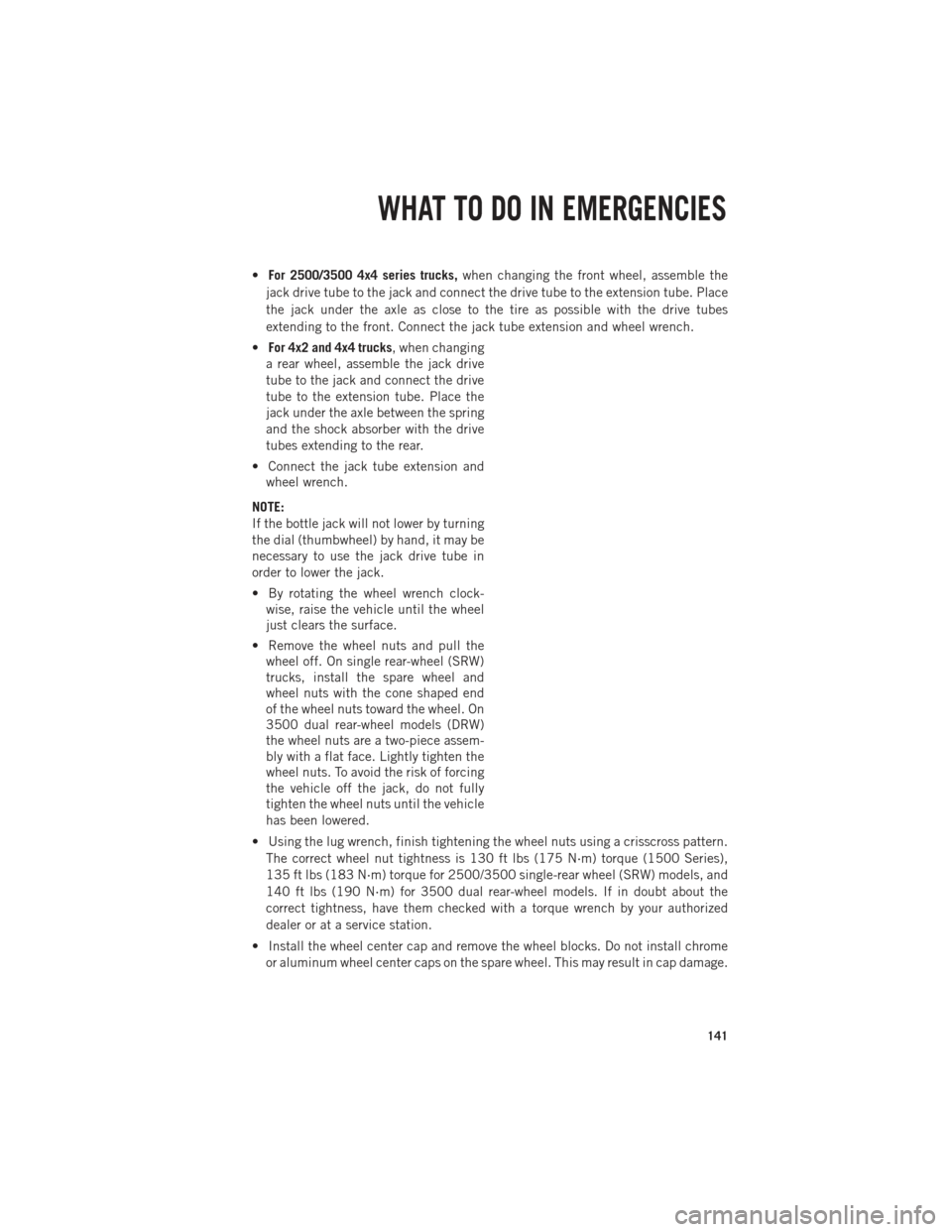
•For 2500/3500 4x4 series trucks, when changing the front wheel, assemble the
jack drive tube to the jack and connect the drive tube to the extension tube. Place
the jack under the axle as close to the tire as possible with the drive tubes
extending to the front. Connect the jack tube extension and wheel wrench.
• For 4x2 and 4x4 trucks, when changing
a rear wheel, assemble the jack drive
tube to the jack and connect the drive
tube to the extension tube. Place the
jack under the axle between the spring
and the shock absorber with the drive
tubes extending to the rear.
• Connect the jack tube extension and wheel wrench.
NOTE:
If the bottle jack will not lower by turning
the dial (thumbwheel) by hand, it may be
necessary to use the jack drive tube in
order to lower the jack.
• By rotating the wheel wrench clock- wise, raise the vehicle until the wheel
just clears the surface.
• Remove the wheel nuts and pull the wheel off. On single rear-wheel (SRW)
trucks, install the spare wheel and
wheel nuts with the cone shaped end
of the wheel nuts toward the wheel. On
3500 dual rear-wheel models (DRW)
the wheel nuts are a two-piece assem-
bly with a flat face. Lightly tighten the
wheel nuts. To avoid the risk of forcing
the vehicle off the jack, do not fully
tighten the wheel nuts until the vehicle
has been lowered.
• Using the lug wrench, finish tightening the wheel nuts using a crisscross pattern. The correct wheel nut tightness is 130 ft lbs (175 N·m) torque (1500 Series),
135 ft lbs (183 N·m) torque for 2500/3500 single-rear wheel (SRW) models, and
140 ft lbs (190 N·m) for 3500 dual rear-wheel models. If in doubt about the
correct tightness, have them checked with a torque wrench by your authorized
dealer or at a service station.
• Install the wheel center cap and remove the wheel blocks. Do not install chrome or aluminum wheel center caps on the spare wheel. This may result in cap damage.
WHAT TO DO IN EMERGENCIES
141
Page 144 of 196

•Lower the jack to its fully closed position. If the bottle jack will not lower by turning
the dial (thumbwheel) by hand, it may be necessary to use the jack drive tube in order
to lower the jack. Stow the replaced tire, jack, and tools as previously described.
• Adjust the tire pressure when possible.
NOTE:
Do not oil wheel studs. For chrome wheels, do not substitute with chrome plated
wheel nuts.
Reinstalling The Jack And Tools
1500 Series Trucks
1. Tighten the jack all the way down by turning the jack turn-screw clockwise until
the jack is snug.
2. Position the jack and tool bag. Make sure the lug wrench is under the jack near the jack turn-screw.
3. Secure the tool bag straps to the jack.
4. Place the jack and tools in the storage position holding the jack by the jack
turn-screw, slip the jack and tools
under the seat so that the bottom slot
engages into the fastener on the floor.
NOTE:
Ensure that the jack slides into the
front hold down location.
WHAT TO DO IN EMERGENCIES
142
Page 145 of 196

5. Turn the wing bolt clockwise to secure to the floor pan. Reinstall the plastic cover.
2500/3500 Series Trucks
1. Tighten the jack all the way down by turning the jack turn-screw clockwise untilthe jack is snug.
2. Position the jack and tools into bracket assembly. Make sure the lug wrench is under the jack near the jack turn-screw. Snap tools into bracket assembly clips.
Install the jack into bracket assembly and turn screw until jack is snug into
bracket assembly.
3. Place the jack and tool bracket assembly in the storage position holding the jack by the jack turn-screw, slip the jack and tools under the seat so that the bottom
slot engages into the fastener on the floor.
NOTE:
Ensure that the jack and tool bracket
assembly slides into the front hold down
location.
4. Turn the wing bolt clockwise to secure to the floor pan. Reinstall the plastic
cover.
WHAT TO DO IN EMERGENCIES
143
Page 146 of 196
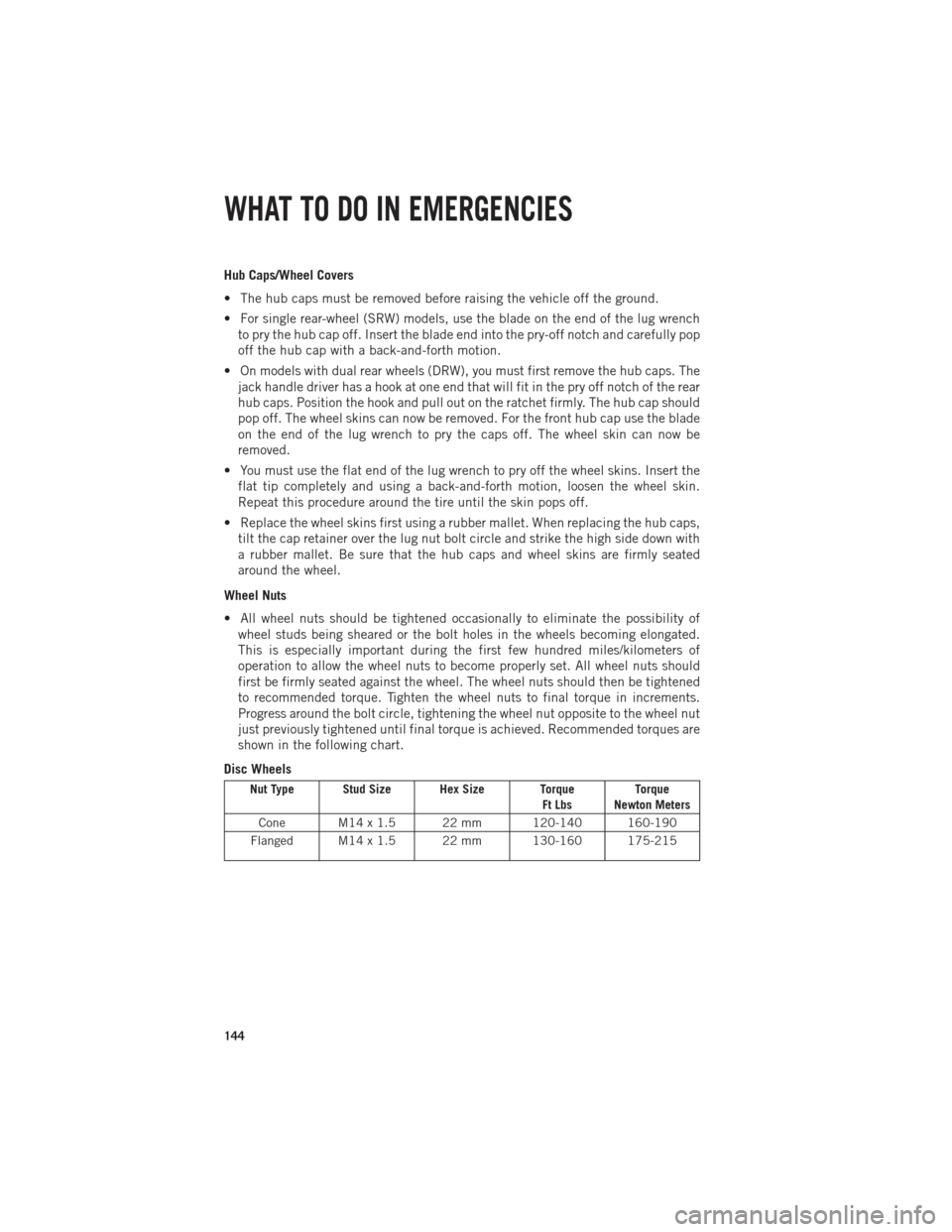
Hub Caps/Wheel Covers
• The hub caps must be removed before raising the vehicle off the ground.
• For single rear-wheel (SRW) models, use the blade on the end of the lug wrenchto pry the hub cap off. Insert the blade end into the pry-off notch and carefully pop
off the hub cap with a back-and-forth motion.
• On models with dual rear wheels (DRW), you must first remove the hub caps. The jack handle driver has a hook at one end that will fit in the pry off notch of the rear
hub caps. Position the hook and pull out on the ratchet firmly. The hub cap should
pop off. The wheel skins can now be removed. For the front hub cap use the blade
on the end of the lug wrench to pry the caps off. The wheel skin can now be
removed.
• You must use the flat end of the lug wrench to pry off the wheel skins. Insert the flat tip completely and using a back-and-forth motion, loosen the wheel skin.
Repeat this procedure around the tire until the skin pops off.
• Replace the wheel skins first using a rubber mallet. When replacing the hub caps, tilt the cap retainer over the lug nut bolt circle and strike the high side down with
a rubber mallet. Be sure that the hub caps and wheel skins are firmly seated
around the wheel.
Wheel Nuts
• All wheel nuts should be tightened occasionally to eliminate the possibility of wheel studs being sheared or the bolt holes in the wheels becoming elongated.
This is especially important during the first few hundred miles/kilometers of
operation to allow the wheel nuts to become properly set. All wheel nuts should
first be firmly seated against the wheel. The wheel nuts should then be tightened
to recommended torque. Tighten the wheel nuts to final torque in increments.
Progress around the bolt circle, tightening the wheel nut opposite to the wheel nut
just previously tightened until final torque is achieved. Recommended torques are
shown in the following chart.
Disc Wheels
Nut Type Stud Size Hex Size Torque Ft LbsTorque
Newton Meters
Cone M14 x 1.5 22 mm 120-140 160-190
Flanged M14 x 1.5 22 mm 130-160 175-215
WHAT TO DO IN EMERGENCIES
144
Page 147 of 196
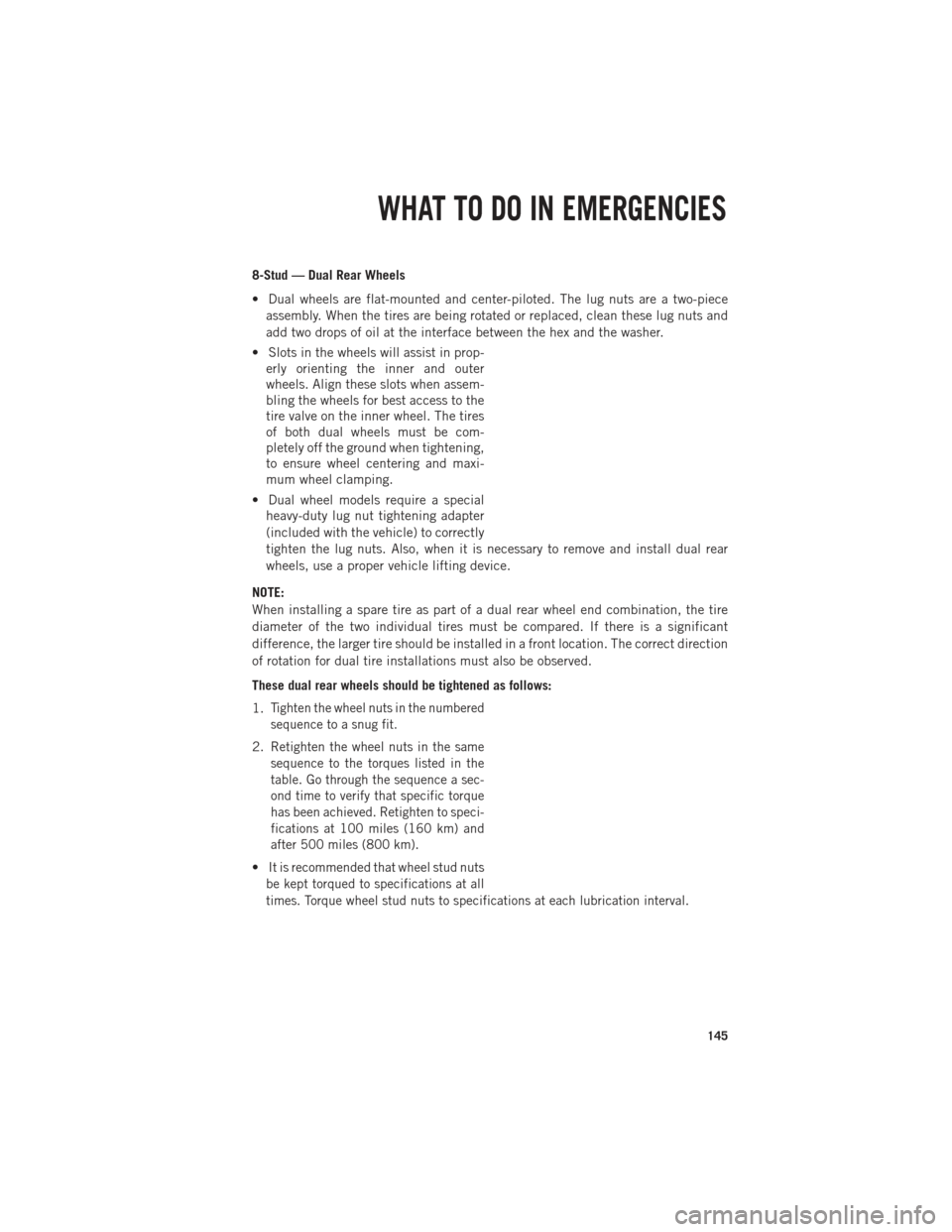
8-Stud — Dual Rear Wheels
• Dual wheels are flat-mounted and center-piloted. The lug nuts are a two-pieceassembly. When the tires are being rotated or replaced, clean these lug nuts and
add two drops of oil at the interface between the hex and the washer.
• Slots in the wheels will assist in prop- erly orienting the inner and outer
wheels. Align these slots when assem-
bling the wheels for best access to the
tire valve on the inner wheel. The tires
of both dual wheels must be com-
pletely off the ground when tightening,
to ensure wheel centering and maxi-
mum wheel clamping.
• Dual wheel models require a special heavy-duty lug nut tightening adapter
(included with the vehicle) to correctly
tighten the lug nuts. Also, when it is necessary to remove and install dual rear
wheels, use a proper vehicle lifting device.
NOTE:
When installing a spare tire as part of a dual rear wheel end combination, the tire
diameter of the two individual tires must be compared. If there is a significant
difference, the larger tire should be installed in a front location. The correct direction
of rotation for dual tire installations must also be observed.
These dual rear wheels should be tightened as follows:
1.
Tighten the wheel nuts in the numbered
sequence to a snug fit.
2.Retighten the wheel nuts in the same
sequence to the torques listed in the
table. Go through the sequence a sec-
ond time to verify that specific torque
has been achieved. Retighten to speci-
fications at 100 miles (160 km) and
after 500 miles (800 km).
•It is recommended that wheel stud nuts
be kept torqued to specifications at all
times. Torque wheel stud nuts to specifications at each lubrication interval.
WHAT TO DO IN EMERGENCIES
145
Page 148 of 196
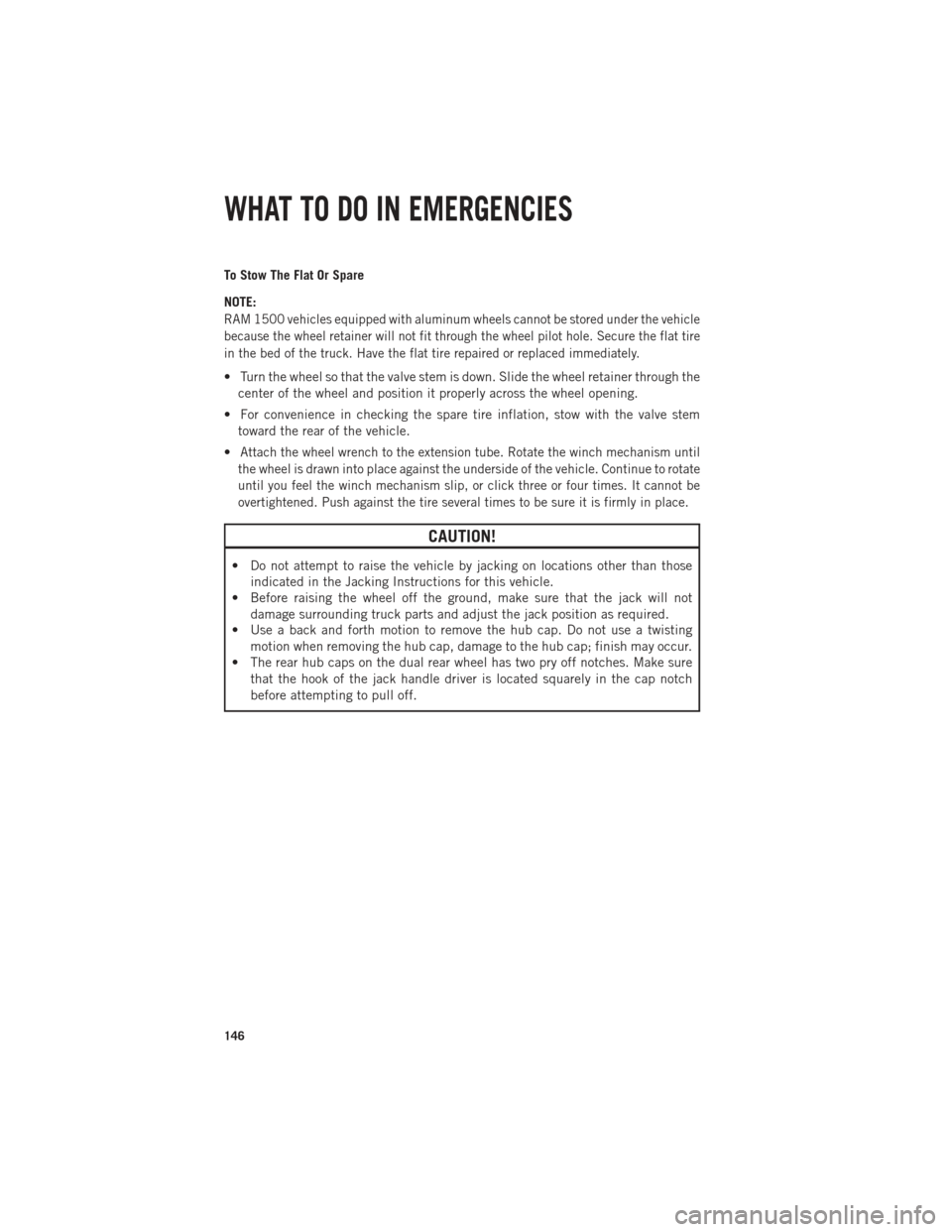
To Stow The Flat Or Spare
NOTE:
RAM 1500 vehicles equipped with aluminum wheels cannot be stored under the vehicle
because the wheel retainer will not fit through the wheel pilot hole. Secure the flat tire
in the bed of the truck. Have the flat tire repaired or replaced immediately.
• Turn the wheel so that the valve stem is down. Slide the wheel retainer through thecenter of the wheel and position it properly across the wheel opening.
• For convenience in checking the spare tire inflation, stow with the valve stem toward the rear of the vehicle.
•
Attach the wheel wrench to the extension tube. Rotate the winch mechanism until
the wheel is drawn into place against the underside of the vehicle. Continue to rotate
until you feel the winch mechanism slip, or click three or four times. It cannot be
overtightened. Push against the tire several times to be sure it is firmly in place.
CAUTION!
• Do not attempt to raise the vehicle by jacking on locations other than those indicated in the Jacking Instructions for this vehicle.
• Before raising the wheel off the ground, make sure that the jack will not
damage surrounding truck parts and adjust the jack position as required.
• Use a back and forth motion to remove the hub cap. Do not use a twisting
motion when removing the hub cap, damage to the hub cap; finish may occur.
• The rear hub caps on the dual rear wheel has two pry off notches. Make sure that the hook of the jack handle driver is located squarely in the cap notch
before attempting to pull off.
WHAT TO DO IN EMERGENCIES
146
Page 149 of 196
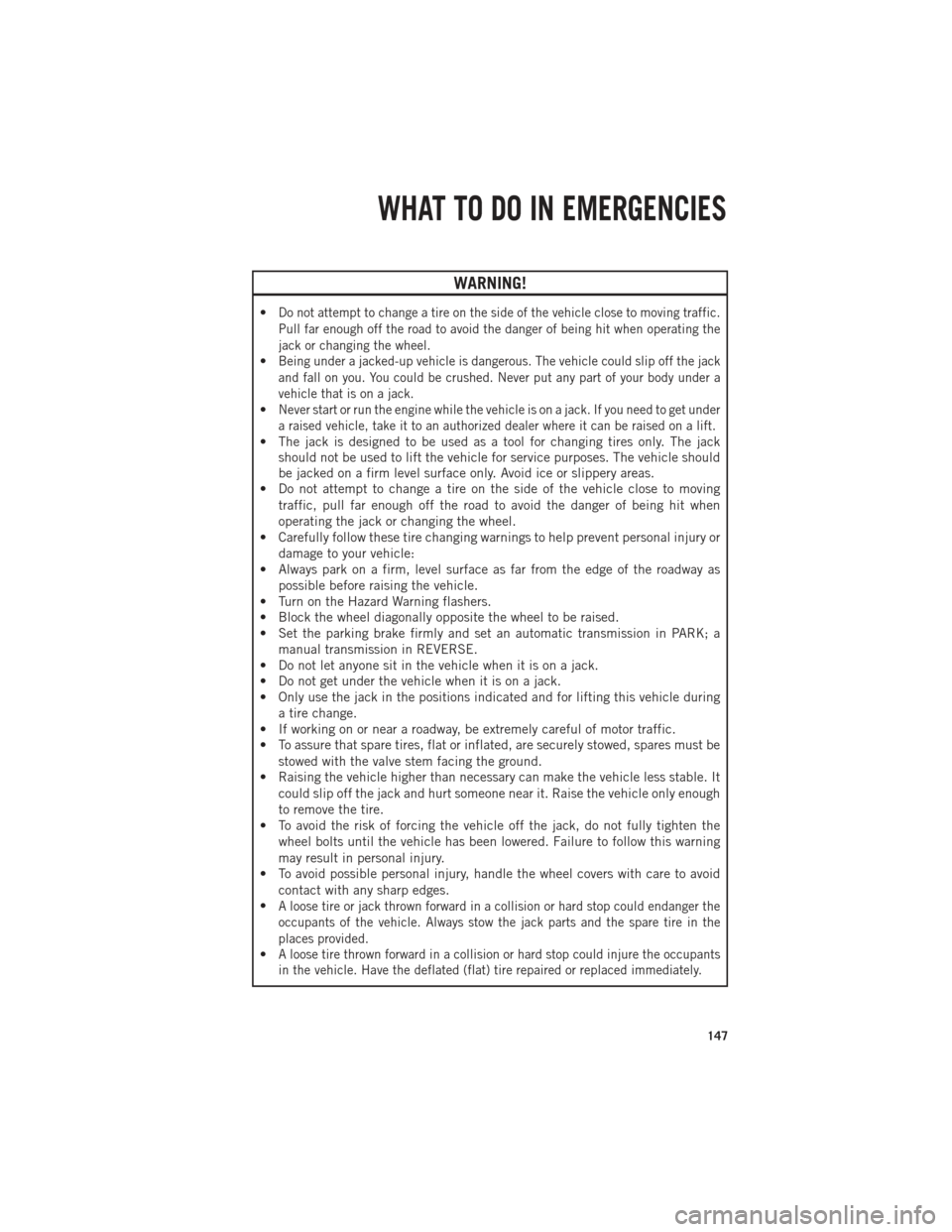
WARNING!
•Do not attempt to change a tire on the side of the vehicle close to moving traffic.
Pull far enough off the road to avoid the danger of being hit when operating the
jack or changing the wheel.
•Being under a jacked-up vehicle is dangerous. The vehicle could slip off the jack
and fall on you. You could be crushed. Never put any part of your body under a
vehicle that is on a jack.
•Never start or run the engine while the vehicle is on a jack. If you need to get under
a raised vehicle, take it to an authorized dealer where it can be raised on a lift.
• The jack is designed to be used as a tool for changing tires only. The jackshould not be used to lift the vehicle for service purposes. The vehicle should
be jacked on a firm level surface only. Avoid ice or slippery areas.
• Do not attempt to change a tire on the side of the vehicle close to moving
traffic, pull far enough off the road to avoid the danger of being hit when
operating the jack or changing the wheel.
• Carefully follow these tire changing warnings to help prevent personal injury or
damage to your vehicle:
• Always park on a firm, level surface as far from the edge of the roadway as
possible before raising the vehicle.
• Turn on the Hazard Warning flashers.
• Block the wheel diagonally opposite the wheel to be raised.
• Set the parking brake firmly and set an automatic transmission in PARK; a
manual transmission in REVERSE.
• Do not let anyone sit in the vehicle when it is on a jack.
• Do not get under the vehicle when it is on a jack.
• Only use the jack in the positions indicated and for lifting this vehicle during
a tire change.
• If working on or near a roadway, be extremely careful of motor traffic.
• To assure that spare tires, flat or inflated, are securely stowed, spares must be
stowed with the valve stem facing the ground.
• Raising the vehicle higher than necessary can make the vehicle less stable. It
could slip off the jack and hurt someone near it. Raise the vehicle only enough
to remove the tire.
• To avoid the risk of forcing the vehicle off the jack, do not fully tighten the
wheel bolts until the vehicle has been lowered. Failure to follow this warning
may result in personal injury.
• To avoid possible personal injury, handle the wheel covers with care to avoid
contact with any sharp edges.
•
A loose tire or jack thrown forward in a collision or hard stop could endanger the
occupants of the vehicle. Always stow the jack parts and the spare tire in the
places provided.
•A loose tire thrown forward in a collision or hard stop could injure the occupants
in the vehicle. Have the deflated (flat) tire repaired or replaced immediately.
WHAT TO DO IN EMERGENCIES
147
Page 150 of 196

JUMP-STARTING
• If your vehicle has a discharged bat-tery it can be jump-started using a set
of jumper cables and a battery in an-
other vehicle or by using a portable
battery booster pack.
•
Jump-starting can be dangerous if done
improperly so please follow the proce-
dures in this section carefully.
NOTE:
When using a portable battery booster
pack follow the manufacturer’s operating
instructions and precautions.
Preparations for Jump-Start
• The battery in your vehicle is located in the front of the engine compartment, behind the left headlight assembly.
NOTE:
The positive battery post is covered with a protective cap. Lift up on the cap to gain
access to the positive battery post.
• Set the parking brake, shift the automatic transmission into PARK and turn the ignition to OFF.
• Turn off the heater, radio, and all unnecessary electrical accessories.
• If using another vehicle to jump-start the battery, park the vehicle within the jumper cables reach, set the parking brake and make sure the ignition is OFF.
Jump-Starting Procedure
• Connect the positive (+)end of the jumper cable to the positive (+)post of the
discharged vehicle.
• Connect the opposite end of the positive (+)jumper cable to the positive (+)post
of the booster battery.
• Connect the negative end (-)of the jumper cable to the negative (-)post of the
booster battery.
• Connect the opposite end of the negative (-)jumper cable to a good engine ground
(exposed metal part of the discharged vehicle’s engine) away from the battery and
the fuel injection system.
• Start the engine in the vehicle that has the booster battery, let the engine idle a few minutes, and then start the engine in the vehicle with the discharged battery.
WHAT TO DO IN EMERGENCIES
148